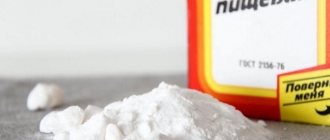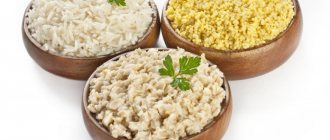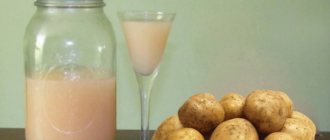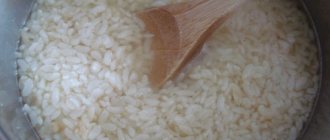Chamomile for gastritis
Chamomile is successfully used to treat chronic gastritis with high, low and normal acidity.
Chamomile is successfully used to treat chronic gastritis with high, low and normal acidity. Usually, after two or three courses of herbal treatment, the secretory function is completely normalized. Chamomile is especially effective for gastritis in children, when the disease is not yet too advanced.
For hyperacid gastritis, chamomile exhibits enveloping and astringent properties, protecting the walls of the stomach and esophagus from hydrochloric acid and eliminating heartburn. Due to the presence of bitterness in its composition, chamomile for gastritis with low acidity increases the production of gastric juice, increases appetite and improves digestion, relieving the patient of discomfort and heaviness in the stomach after a hearty meal, suppresses fermentation in the intestines, improves stool and reduces the amount of gas.
During exacerbations of gastritis, only weak infusions of chamomile are allowed. After relieving acute pain, you can drink strong infusions at the rate of 3-4 teaspoons of chamomile flowers per glass of water or drink a cup of chamomile tea in two doses. Chamomile decoctions are consumed during remission, as well as in spring and autumn for preventive purposes.
Chamomile almost never causes serious harm to the body, but before starting a course of treatment, it is necessary to undergo an examination and exclude direct contraindications. Due to the high content of phytoestrogens, chamomile also has relative contraindications for women for gastritis - pregnancy and breastfeeding, taking hormonal medications and oral contraceptives. If you are prone to constipation, it is better to drink chamomile as part of a tea - then herbs with a laxative effect, such as senna or buckthorn, will balance its astringent effect and help avoid stool upset.
Unique properties of chamomile
Chamomile is an essential component of most folk medicines. It contains many substances that improve the functioning of all body systems. This flower can serve as an alternative to expensive pharmaceutical drugs. It is used for the following purposes:
- pain relief;
- normalization of the nervous system;
- restoration of the mucosa;
- reduction of swelling;
- improved blood circulation;
- healing of small wounds;
- fight against insomnia;
- relief from toothaches;
- improving the functioning of the liver and gallbladder;
- treatment of gynecological diseases.
Most often, the plant is used for problems with the stomach and intestines.
Impact on the gastrointestinal tract:
- envelops the walls of the stomach;
- heals ulcers;
- prevents inflammatory processes;
- eliminates gas formation;
- relieves colic;
- relieves spasm;
- improves peristalsis.
How to properly prepare and take chamomile for gastritis
Chamomile is an annual plant with a specific odor. Since ancient times, it has been considered one of the strong and reliable means that can kill pathogenic microflora and have a healing effect. For treatment, dried or fresh chamomile flowers are used, containing a huge amount of essential oils, flavonoids, a complex of tannins, a group of vitamins, various acids (salicylic, stearic, oleic and others).
Chamomile is widely used for gastritis as a natural antibiotic. Essential oils have a disinfectant effect, normalize intestinal activity, relieve spasms and internal swelling. For gastritis with high acidity, chamomile dilutes the concentration of juice and relieves increased irritation of the mucous membrane.
How to properly prepare and take chamomile tea for gastritis
They drink chamomile tea not only for hypersecretory gastritis, but also for anacid
gastritis. They drink chamomile tea not only for hypersecretory gastritis, but also for anacid gastritis. The main effect of the plant is to reduce inflammation and relieve pain. To prepare chamomile tea, pour 1.5 teaspoons of flowers into a glass of moderately hot water, let stand for 15-17 minutes, strain the solution through a sieve, drink in small sips during stomach discomfort. To enhance the healing effect, you can add fresh honey to the tea if you do not have an allergic reaction to bee products.
How to properly prepare and take chamomile decoction for gastritis
Chamomile decoction for gastritis is used during the period of remission. To prepare a herbal decoction, you need to pour a full tablespoon of inflorescences with one glass of clean water and simmer for 24 minutes in a water bath. Or pour dried chamomile flowers into an enamel container, add a small amount of purified cold water, put on low heat, after boiling, wait 3-4 minutes and turn off. Then let the mixture cool, take 2-3 times a day before meals and before bed.
How to properly prepare and take chamomile infusion
Chamomile infusion can be used during periods of mild exacerbation and the appearance of minor symptoms, when the symptoms are sluggish and do not cause severe concern. To do this, brew a spoonful of flowers with boiling water and leave to infuse in a thermos for 4 hours. Take the infusion warm, before meals, a quarter glass. This method allows you to reduce the concentration of secretions in the stomach, thus protecting the mucous membrane from excessive irritation. You can only drink chamomile for gastritis to eliminate possible complications.
In the autumn-winter period, chamomile can be drunk as a prophylaxis to reduce the exacerbation of the disease. For 2 weeks, an infusion or decoction of the plant should be consumed 1-2 times a day, 25-30 minutes before meals.
Composition and medicinal properties
Chamomile contains a large number of biologically active components that improve the condition of the body. These include: chamazulene, gum, vitamin C, vitamin A derivative, minerals, polysaccharides, polyacetylenes, organic acids, flavonoids, coumarins, essential oil. The qualitative and quantitative composition of the plant varies depending on the region where it is collected.
Advice. It is better to purchase dried chamomile flowers from a pharmacy, as they undergo proper testing. In chamomile purchased “from hand” or collected independently, the concentration of heavy metals may exceed the permissible limit, which is confirmed by laboratory tests.
Thanks to its beneficial substances, the plant has an effect on almost all body systems:
- suppresses the inflammatory response;
- normalizes digestion;
- calms;
- stops bleeding;
- fights germs;
- relieves cramps and muscle spasms;
- reduces pain.
The effects of chamomile largely depend on the dosage form, dosage and initial state of the body. Most often, the plant is prescribed to correct digestive disorders.
Pharmaceutical chamomile for gastritis
The positive effect of chamomile for gastritis is associated with the following mechanisms:
- normalization of motility, prevention of reflux;
- reduction of bloating;
- anti-inflammatory effect on the mucous membrane;
- astringent, hemostatic properties;
- increased bile secretion;
- reduction of abdominal pain;
- fight against Helicobacter and other pathogens of the infectious process.
Chamomile has little effect on the production of hydrochloric acid and gastric enzymes. While taking it, secretion may decrease slightly, but the pH level will not change significantly. That is why the plant can be used even for anacid gastritis.
Chamomile and gastritis
Chamomile decoction for gastritis is used for both acute and chronic illness, as well as for high and low secretion of gastric juice.
The drink can be prepared in several ways:
- pour boiling water over a small handful of chamomile and let it brew for one hour;
- simmer the water with chamomile in a water bath for thirty minutes. This is how you can get a highly concentrated decoction. For this reason, before use, it must be diluted with purified warm water;
- add a few tablespoons of dried chamomile to cold water, then let the mixture boil.
For gastritis, you need to drink one glass of chamomile two or three times a day, always before meals. In addition, when treating gastritis, the use of chamomile tea is not prohibited, which can be prepared using only this ingredient or adding many other medicinal plants to it. To eliminate this disease, you need to drink this drink before eating food, in the amount of 200 milliliters.
There are several recipes for medicinal chamomile tea:
- A few teaspoons of dried chamomile are poured into a glass of hot water and allowed to brew for no more than thirty minutes, after which it is filtered. This drink can be drunk both in pure form and when combined with other types of tea;
- Take equal parts dried chamomile flowers and peppermint leaves and pour a glass of boiling water over them. Let them brew for a few minutes, then strain. Only after such manipulations is the tea ready for drinking;
- chamomile tea with lemon balm added. The method for preparing this drink is similar to the previous one. It is best to drink it warm, several times a day. To enhance the taste and healing properties, it is recommended to add a little honey;
- tea with the addition of a collection of herbs, which includes chamomile, mint, sweet clover and St. John's wort.
Even if there are no restrictions on consumption, do not forget about moderate consumption of chamomile for gastritis. Any medicine, even if it is a plant, can cause harm to the body if the dosage is exceeded.
General information about the plant
Chamomile is an annual plant that belongs to the Aster family. It comes in several types:
- garden white and yellow;
- pharmacy;
- Persian;
- German and Caucasian.
Chamomile is used for medicinal purposes. This is a time-tested, strong and reliable remedy that has beneficial properties for the body. The flowering period of the plant is from May to August. Most often, inflorescences with pedicels are collected in dry sunny weather at the beginning of flowering. Their length should not exceed 3 cm. Then the flowers are dried in specially created conditions.
Chamomile is collected in spring and summer, since its marginal reed flowers are located horizontally and during this period the plant is rich in necessary biologically active substances. If this moment is missed, then during the drying period the plant’s basket disintegrates and beneficial essential oils evaporate.
It is recommended to store dried chamomile for no more than a year in a well-sealed container.
Composition of chamomile
This medicinal herb contains a complex of unique elements and substances that provide the prevention and treatment of stomach disease. These elements complement each other perfectly, and the uniqueness of their properties cannot be overestimated. Chamomile includes:
- essential oils;
- flavonoids;
- tannins;
- polysaccharides;
- vitamins;
- salicylic, stearic, oleic, as well as isovaleric and palmitic acid.
Properties of flowers
For stomach and duodenal ulcers, as well as for various forms of gastritis, chamomile can destroy pathogenic microflora, acting as a natural antibiotic. Thanks to the content of a huge amount of essential oils, inflammatory processes are effectively stopped, severe pain and spasms are relieved throughout the digestive tract.
The oil serves as an excellent wound healing agent, which is important in the fight against chronic diseases of the stomach and intestines. The astringent property of the plant contributes to the rapid restoration of the mucous membrane
Chamomile is able to remove dangerous and harmful toxins from the body, and also reduces the likelihood of the formation of malignant tumors.
The substances in medicinal chamomile dilate blood vessels, thus relieving internal swelling by normalizing blood flow. The healing properties of this plant ensure successful treatment of ailments and prevent disruption of the functioning of the digestive system. They relax the mucous membrane, reduce the formation of gases, eliminate fermentation processes and activate the functions of the digestive organs.
In addition, chamomile flowers have a choleretic effect, which is important when establishing proper functioning of the gastrointestinal tract. It has been proven that the components of this herb suppress the activity of the Helicobacter pylori bacterium, increasing the defenses of the immune system and stimulating the growth of its resources.
It has been proven that the components of this herb suppress the activity of the Helicobacter pylori bacterium, increasing the defenses of the immune system and stimulating the growth of its resources.
How to properly use chamomile for gastritis
For gastritis, taking chamomile helps relieve the patient's abdominal pain and improve digestion.
For gastritis, taking chamomile helps relieve the patient's abdominal pain and improve digestion. In the treatment of chronic gastritis, systematic use of chamomile preparations promotes faster regeneration of the gastric epithelium. It is impossible to completely cure gastritis with chamomile alone, since chamomile preparations do not affect the causes of the disease.
The effect of chamomile preparations is approximately the same both for gastritis with increased acidity of gastric juice and with normal or reduced concentration of acids. These drugs do not dilute gastric juice and do not affect its effect on the epithelial lining; they only affect the epithelium itself and its inflamed areas.
However, in folk medicine, chamomile tea is preferred to treat almost exclusively gastritis with low acidity.
Also, the beneficial effect of chamomile is manifested in the presence of diseases associated with gastritis: pancreatitis, cholecystitis, colitis and other inflammatory diseases of the digestive tract. Preparations of this plant have an effect similar to that in the stomach and on other parts of the gastrointestinal tract, but in the distal parts of the intestine its effect is weaker. At the same time, if you have heartburn, which often accompanies gastritis, it is not advisable to drink chamomile.
Chamomile tea or decoction is almost always used to treat gastritis. The difference between these means is that tea is prepared by pouring hot water over dry flowers and brewing without boiling for a certain time, while the decoction is boiled over a fire for a while.
For gastritis, you need to drink 1 glass 2-3 times a day, preferably before meals, so that the remedy acts on the surface of the gastric mucosa free from food bolus. If you drink the product after eating, it will mix with food and the effect of its use will be blurred. Chamomile is included in a variety of gastrointestinal herbal preparations, including those used for gastritis. Often chamomile remedies (especially strong ones) are prepared with honey to slightly smooth out the bitterness imparted to the drug by the chamomile itself. With gastritis this is quite acceptable.
In all these recipes, you can use both raw chamomile, sold in loose form, and chamomile flowers in bags. When using filter bags, you should remember that one teaspoon of chamomile contains 3 grams of dried flowers. Different amounts of chamomile are packaged in different bags from different manufacturers (from 1.5 to 5 g per bag), so a separate recalculation has to be done for each product.
The course of treatment with chamomile lasts as long as the patient feels abdominal pain. For acute gastritis, chamomile preparations should be taken, as a rule, for 4-5 days, after which the disease ends. For a chronic disease, the doctor will indicate how long you should drink chamomile, how to combine it with other medications, and when to take it during the day to avoid undesirable effects on the action of other medications. Other ways to use chamomile for gastritis, other than taking it orally, are not known.
Who is not recommended to take it?
Drinking chamomile tea is not recommended for those who are allergic to this plant. If you have been diagnosed with hypoacid gastritis with zero or low acidity, then each traditional medicine must be agreed with a doctor. If the treatment phase for stomach diseases is in full swing, drinking herbal infusions is prohibited. If remission is observed, it is necessary to monitor the body's reaction.
You should stop drinking chamomile if you experience nausea, aching pain in the stomach, vomiting, nervousness, heaviness in the stomach and dizziness. After stopping treatment, you should undergo examination. Do not take chamomile with alcohol. You cannot drink decoctions and infusions with blood-thinning and sedatives.
Chamomile is very gentle on the stomach, however, in infants it can wash out the intestinal microflora.
Doctors do not recommend drinking chamomile to pregnant women or those who are planning to conceive. Young children can be bathed in decoctions to relieve diathesis rashes and inflammatory processes. Infants can be given the infusion only after consultation with a pediatrician. It is forbidden to violate the frequency of administration and dosage.
Remember that chamomile can be very helpful for stomach pain. However, if you experience constant spasms, pain and disturbances in the gastrointestinal tract, you should consult a specialist for help. Otherwise, you will constantly relieve pain, and the serious problem will get worse.
If you have serious problems, consult your doctor before taking the infusion or decoction. It is also a good idea to consult a doctor before taking various herbs if you are pregnant. So, you can definitely protect yourself from the negative consequences of taking it.
How to use chamomile for gastritis for treatment
The benefits of the plant are related to its medicinal composition. Chamomile contains monoterpene oils, prochamazulene and chamazulene, plant vitamins, and alcohols. These components have anti-inflammatory, disinfecting and soothing effects. Therefore, chamomile has a healing effect for gastritis. You just need to use it correctly.
Typically, gastritis causes pain, cramping and other signs of discomfort. Using a remedy with this plant reduces the manifestation of these symptoms. Chamomile has an antacid effect if the disease causes increased acidity, as well as belching and reflux. Medicines with this plant protect against malignant neoplasms and remove harmful toxins.
Chamomile infusion for gastritis helps normalize the formation of gastric juice. Chamomile for gastritis with high acidity is an antacid that lowers acidity and has an astringent effect. It also helps get rid of inflammation. If dyspepsia is observed during the disease, then the use of chamomile infusion eliminates pathogenic microorganisms, due to which the discomfort goes away and an improvement occurs in the stomach. The plant can be used during pain. You just need to drink chamomile tea (1 glass) for the pain to disappear.
Chamomile decoction for gastritis
Chamomile decoction for gastritis is considered a very effective remedy. To obtain it, you need dried flowers (1 tbsp), which are filled with boiled water (1 glass). The decoction should steep for 15 minutes. It should be consumed 2 times daily before meals. There is another option for preparing a medicinal product: you need dried flowers, which are filled with cold water. The mixture must be brought to a boil. Its therapeutic effect will be the same. After cooling, the composition is ready for use.
Chamomile tincture for gastritis
A cold infusion is also effective, for the preparation of which you will need dried flowers (1-2 tbsp.).
They are filled with chilled boiled water (1 glass). The product is infused for 10 hours. It should be consumed before meals. For gastritis, chamomile can be used in this form. To do this you will need dried flowers (1 tbsp.), boiling water (250 ml.). Everything should be infused in a thermos for 2.5 hours. The infusion should be used warm, ¼ glass 3-4 times a day before meals.
A cold infusion is also effective, for the preparation of which you will need dried flowers (1-2 tbsp.). They are filled with chilled boiled water (1 glass). The product is infused for 10 hours. It should be consumed before meals.
You can use an alcohol tincture, for the preparation of which you need to fill the flowers with vodka in an amount of 1/10. After this, the mixture should infuse for 3 weeks in a dark place. It needs to be shaken periodically. Treatment involves consuming 2 tbsp. infusion after meals. A full course of treatment will help get rid of the symptoms of the disease.
Chamomile tea for gastritis
For gastritis, chamomile tea will be a remedy that will help you get rid of spasms and pain. You only need 1 glass, which should be drunk with the onset of attacks so that the discomfort disappears.
To prepare tea, you will need chamomile flowers (1.5 tsp), which are poured with boiling water (1 cup). Everything should infuse for 10-12 minutes, after which the drink is ready to drink. You need to drink it in small sips. If desired, honey is added to the tea, which has a healing antibacterial effect.
There is another recipe for making tea. The flowers need to be mixed with peppermint in a ratio of 1/1, pour boiling water over it. Let everything sit for 10-15 minutes. After this, the tea can be consumed in small sips. Chamomile goes well with lemon balm. You can also use the decoction with honey (1 tsp). Chamomile tea eliminates the symptoms of gastritis. You can also use sweet clover, St. John's wort, and plantain, as these herbs have a healing effect and relieve inflammation, swelling, and pain.
Chamomile-based medicines
- Pepsan P contains a synthetic analogue of azulene – guaiazulene and dimethicone. The latter is able to reduce gas formation and cover the walls of the digestive tract with a protective film. This drug is used as an antacid. It has fewer side effects than the proton pump inhibitors traditionally used in this group. The general effects of this drug are:
- neutralization of free hydrochloric acid in the stomach;
- decrease in intracavitary pressure in the stomach;
- antispasmodic effect;
- counteracting duodenogastric reflux;
- normalization of evacuation of the food bolus from the stomach into the duodenum.
- Camilloside is a Russian-made ulcer-healing drug, consisting of a polysaccharide complex of chamomile inflorescences. Binds hydrochloric acid in gastric juice, has an enveloping effect, and can enhance gastrointestinal motility.
- Romazulon is a Romanian drug that contains 96% chamomile extract and 0.3% of its essential oil. It is used as an anti-inflammatory agent for rinsing the mouth for stomatitis, etc. It is also used for rinsing for various inflammatory pathologies. For example, with trophic ulcers, colpitis. For gastritis, the method is indicated for oral administration if dyspeptic disorders are accompanied by flatulence.
Chamomile for gastritis with high acidity
For medicinal purposes, this type of chamomile is used as medicinal. Chamomile for gastritis with high acidity should be taken with caution, as there are contraindications.
Chamomile decoction for gastritis is prepared in several ways:
- Method one: pour boiling water over the flowers of the plant and leave the mixture for 60 minutes. Then they consume;
- method two: to prepare a richer decoction, you should take less water and more inflorescences. Heat everything in a water bath for 30 minutes and strain. By diluting with water, the broth is brought to the desired strength;
- method three: the flowers are placed in an enamel container and filled with clean water. Bring to a boil over low heat and simmer for a couple of minutes.
Recipe for making chamomile for gastritis with high acidity
10 grams of flowers are combined with a glass of water. Leave for at least 4 hours. Strain. Take this drug twice a day, a quarter of an hour before meals, ½ cup. In this case, the infusion should be slightly warmed up. It is important for the correct infusion so that the flowers of the plant do not have time to fully bloom.
In addition to the above recipes, the infusion can be prepared with alcohol. The flowers of the plant must be filled with alcohol, while maintaining a ratio of 1:10. Leave the mixture in a dark place for 21 days. Filter before use.
Use of chamomile for heartburn
The main indication for the use of chamomile preparations is diseases of the digestive system. Heartburn is a symptom of indigestion in which acidity increases.
Can these chamomile preparations help with this ailment? There are those who believe that in this case, chamomile is contraindicated because it causes increased secretion of gastric juice and increases appetite. Chamomile tea actually improves digestion without causing acidity.
Chamomile infusions and decoctions are indicated for gastritis, spastic colitis, accompanied by fermentation and flatulence in the intestines. Improve digestion and stimulate bile secretion. Effectively used in the treatment of gastric and duodenal ulcers, hyperacid (high acidity) gastritis.
Peptic ulcers and gastritis with high acidity are always accompanied by heartburn, which can be helped by preparations brewed from chamomile inflorescences.
Chamomile decoction for the treatment of gastritis
The decoction is made by boiling the flowers for 15 – 20 minutes over low heat.
Then turn off the heat and allow the mixture to cool gradually. The decoction is made by boiling the flowers for 15 to 20 minutes over low heat. Then turn off the heat and allow the mixture to cool gradually. At this time, some of the components will also pass into the water. After this you need to strain it. Drink the clean liquid warm. The dosage and time of administration depend on the disease.
An upset stomach can be treated with chamomile infusion, prepared over low heat or in a thermos. You need to fill the flowers and pour boiling water in a ratio of 5 grams per 500 ml. Keep in a thermos for 3 hours and strain. Take the decoction warm in a glass or a liter throughout the day. To enhance the effect, especially in case of poisoning, it is advisable to do an enema with the addition of chamomile.
Wax softens the walls and increases their permeability. Beneficial substances are absorbed and carried by amino acids throughout the cells. Toxins are washed out and removed. Fermentation of leftover food and gas formation stops. Chamomile relieves pain and relieves spasms. As a result, colic goes away. Chamomile tea with mint is prepared for children: 1 teaspoon of chamomile; a pinch of dry mint. 200 – 250 ml boiling water.
It is recommended to drink the decoction 3 times a day before meals 30 minutes. The drink should be warm, approximately 30 - 35 degrees, without sugar. You can add a teaspoon of honey for taste. After this, it is advisable to lie on your side so that the surface of the walls inside is completely irrigated with tea or decoction.
For erosive gastritis with low acidity, you should discuss taking chamomile with your doctor. Once inside, chamomile relieves inflammation and kills bacteria, including Hilobacter Pylori, which causes stomach disease. Mucus envelops the walls, creating additional protection. Amino acids and trace elements accelerate cell regeneration and enzyme reproduction. Food is processed faster after drinking chamomile tea.
Sources:
- https://zen.yandex.ru/media/id/5b3c8f89d8c4f600a8ba76cc/romashka-pri-gastrite-skoraia-pomosc-bolnomu-jeludku—5b430f974f3fe700a9c4fd4d
- https://gastritinform.ru/ozhkt.com/zheludok/gastrit/romashka-pri-gastrite.html
- https://gastritinform.ru/perekis-i-soda.ru/romashka-pri-gastrite/
- https://bolvzhivote.ru/gastrit/romashka-pri-gastrite-i-mozhno-li-pit-romashku.html
- https://herbarix.ru/romashka/primenenie-v-meditsine/romashka-pri-gastrite.html
- https://gastritinform.ru/pozheludku.ru/pitanie/dlya-zheludka/romashka-dlja-zheludka-i-kishechnika.html
- https://sammedic.ru/332998a-kak-primenyat-romashku-pri-gastrite-dlya-lecheniy
Contraindications and side effects
It is prohibited to treat gastritis with chamomile in the anacid form of the disease. The pathology is characterized by a stop in acid production due to atrophy of the secretory cells of the mucous membrane. In this case, chamomile herbal medicine will increase pain symptoms.
The use of chamomile is contraindicated:
- with relapses of peptic ulcer and chronic pancreatitis;
- during the perinatal and lactation period (phytoestrogens increase the tone of the uterus, which provokes the threat of miscarriage);
- patients with cholecystolithiasis and choledocholithiasis (the effect of the herb can cause the movement of stones in the gallbladder and bile ducts);
- in case of an allergic reaction to plant components.
Relative contraindications include hypotension. Folk remedies based on chamomile slightly reduce blood pressure.
Chamomile for gastritis should be drunk no more than 1-2 cups a day
Side effects develop due to incorrect treatment:
- excess dose;
- increasing the therapeutic course;
- increased concentration of the drug.
Undesirable effects include cephalalgia (headache), psycho-emotional instability, nausea, and increased fatigue.











